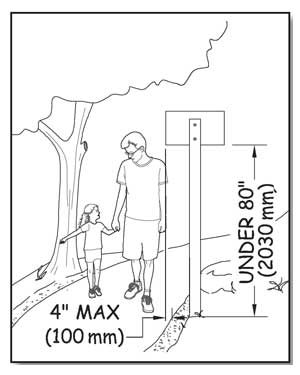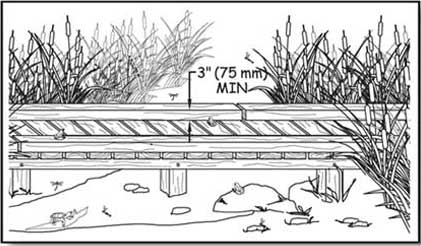Protruding Objects and Outdoor Recreation Access Routes
Objects that extend into the travel way of an outdoor recreation access route from the side or from overhead can be hazardous to people who are paying more attention to their companions than the travel route, as well as to people who are blind or have low vision. Protruding objects are defined as constructed features (such as signs) that extend into the clear width area of an outdoor recreation access route, resting interval, or passing space and that are between 27 inches (685 millimeters) and 80 inches (2,030 millimeters) above the travel surface. Do not allow constructed features to extend into the clear width area more than 4 inches (100 millimeters, figure 45).

Figure 45—Constructed features can't extend into the clear width area more than 4 inches if they are between 27 and 80 inches (685 to 2,030 millimeters) above the walking surface.
Accessibility guidelines do not consider natural elements (such as tree branches and rock formations) to be protruding objects. Provide and maintain clearance from natural elements around outdoor recreation access routes in accordance with your unit's standards, keeping in mind overhanging hazards to people who are blind or have low vision, or are not focused on the route ahead.
Design Tip
Edge protection may be used for outdoor recreation access routes.
Edge protection is a raised curb, wall, railing, or other structure that defines the edge of a travel surface and may help keep people on the travel surface. Edge protection is not required for accessibility on outdoor recreation access routes, and it is not usually desirable in outdoor environments because it isn't as easy to see or detect objects near the ground. However, edge protection may be desirable for safety or other reasons. Edge protection curbs (figure 46) in an outdoor environment are required to be at least 3 inches (75 millimeters) high.

Figure 46—Edge protection is optional on an outdoor recreation access route, but if present, edge protection must be at least 3 inches high.

User Comments/Questions
Add Comment/Question